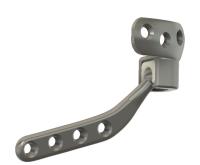22 Apr 2024
Vets pioneer jaw joint replacement implant for cats and dogs
Team at University of California, Davis School of Veterinary Medicine gains patent pending status for device that could revolutionise treatment for animals with end-stage temporomandibular joint disorders.

UC Davis veterinarians and biomedical engineers teamed up to develop a jaw joint replacement implant for cats and dogs with end-stage temporomandibular joint disorders. Image © UC Davis
Vets at a US vet school have developed a jaw joint replacement implant they hope will revolutionise treatment for cats and dogs with end-stage temporomandibular joint (TMJ) disorders.
A team at the University of California, Davis (UC Davis) School of Veterinary Medicine has gained patent pending status on a TMJ replacement (TMJR) prosthesis that could aid pets with non-functioning TMJs due to injury or disease.
Initial research about the TMJR has been published in the American Journal of Veterinary Research.
Replacement
Boaz Arzi, chief of the Dentistry and Oral Surgery Service at UC Davis, said: “About five years ago, I suggested the need for a TMJR because we were seeing increased number of cats and dogs with fused jaws.

“The only recourse we have for these animals is to remove all the affected structures in the jaws to enable opening the mouth.
“While this allows the patient to eat and drink, there is no longer functionality to the joint, and their mouth can never close properly again.”
Robust testing
Dr Arzi added: “Joint replacement in animals is well established in hips, and strides are in place also for the knees and elbows. Why not for the TMJ like in people with similar condition? Let’s create one.”
He partnered with Denis Marcelin-Little, a UC Davis veterinary orthopaedic surgeon with a background in hip replacement and implant design, and Tanya Garcia, a biomedical engineer in the school’s JD Wheat Veterinary Orthopedic Research Laboratory.
The TMJR is loosely based on one authorised in the US for use in humans, and is described as a hybrid of that and a hip replacement implant.
Robust testing of the maximum force the implant can withstand is ongoing, and suitable patients will be evaluated soon for a pre-clinical trial of the TMJR implant.
